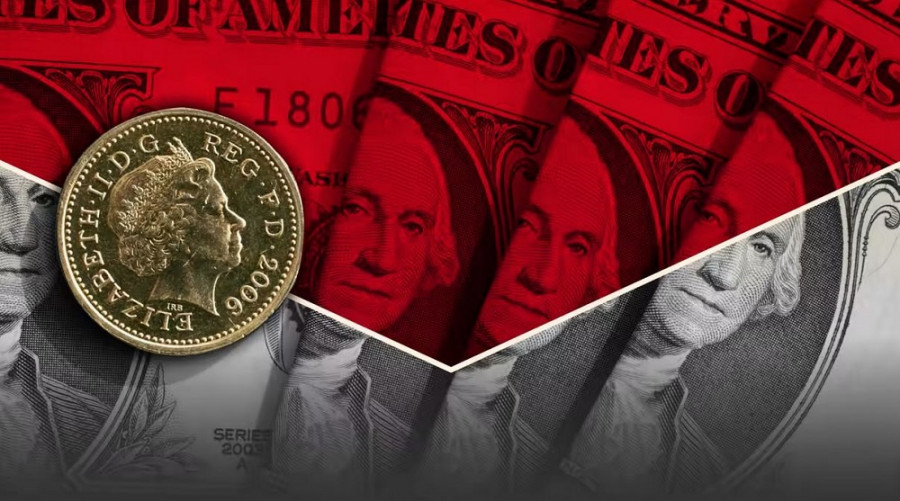
On Thursday, the GBP/USD pair hit a four-week low in response to the outcomes of the Bank of England's August meeting. Although the central bank implemented the "base," most anticipated scenario, the beneficiaries of the situation were the GBP/USD bears. They tested the support level at 1.2650 - at this price point, the lower line of the Bollinger Bands indicator coincides with the upper band of the Kumo cloud on the daily chart. If sellers break through this price barrier and settle below it, the next target for the bearish movement will be 1.2550 - the lower band of the aforementioned cloud on the same chart.

The British currency is plummeting across the market despite several hawkish circumstances. First of all, the BoE raised its interest rate by 25 basis points, bringing it to 5.25%. However, traders ignored this fact, even though the central bank assured the markets that its monetary policy would remain restrictive "for a considerable period." Secondly, market participants overlooked the fact that it appears that the "dovish wing" within the central bank is getting weaker. For many months, two out of nine committee members voted to keep the rate unchanged. However, after the August meeting, the balance shifted, with eight committee members voting in favor of a rate hike, and only Swati Dhingra voting to keep rates unchanged. In addition, two central bank officials (Haskel and Mann) advocated for a 50-basis-point rate hike. While the formal outlook did not change, such shifts indicate the dominance of hawkish sentiment within the BoE, at least during the August meeting.
GBP/USD traders also ignored these developments. The pound came under pressure from cautious comments by BoE Governor Andrew Bailey. Additionally, the updated inflation forecast played a role, as the BoE expects significant inflation deceleration by the end of this year.
Bailey faced criticism in July from British politicians and journalists, who accused the central bank of losing control over inflation. Bailey had to defend and refute these accusations. While he acknowledged that risks of more persistent inflation have "crystallized," he disagreed that the central bank should act more aggressively. Bailey focused on the side effects of aggressive policies and mentioned that the central bank had faced "some uncomfortable surprises," so when making the rate decision, the committee members "considered all existing risks."
The BoE experienced several "unpleasant surprises" last month, mainly related to the UK GDP report. The economy unexpectedly contracted by 0.1% (against a forecast of 0.1% growth), compared to the previous month's growth of 0.2%. Industrial production decreased by 0.6% in monthly terms and by 2.3% in annual terms. Manufacturing output declined by 1.2% year-on-year, while a 1.7% decline was forecasted.
By mentioning the unpleasant surprises, Bailey implied that the prospects for further monetary tightening are uncertain. He stated that it is not yet time to talk about the end of the current cycle of monetary tightening, but at the same time, there is "no prejudged path or trajectory for the interest rate." In this context, he added that the central bank will decide on the most appropriate rate change trajectory "based on actual data."
Bailey also mentioned that the forecast for economic activity has "significantly weakened."
At the same time, the BoE forecasted a significant slowdown in the pace of consumer price growth in Britain by the end of this year, approximately to around 5% ("or slightly lower"). According to economists at the Bank, this will be supported by the deceleration of energy and partly food prices. The inflation is expected to return to the target two percent level closer to the second quarter of 2025. It's worth noting that June's inflation in the UK sharply declined in annual terms to 7.9% from 8.7% in May. This is the slowest pace of growth since March 2022.
In conclusion:
1). The BoE raised the interest rate for the 14th consecutive time, but this fact had already been priced in by the market, so the main focus was on the "post-factum" rhetoric.
2). The language used in the accompanying statement and Bailey's rhetoric disappointed GBP/USD buyers, as the wording weakened hawkish expectations regarding the central bank's future actions. From the text of the final communique, it can be inferred that the central bank considers the current monetary policy to be restrictive. This fact suggests that either the peak of rate hikes has already been reached or is very close. This assumption is further exacerbated by the fact that the updated BoE forecasts indicate weaker growth compared to the May forecast and an impending labor market slowdown.
3). The pound has essentially lost a strategically important ally: after previous meetings, the BoE hinted at further steps towards tightening monetary policy, providing support to the British currency. However, after the August meeting, the Bank refrained from such hints, although it did not formally rule out a rate hike at one of the subsequent meetings.
All of these conclusions are not favorable for GBP/USD buyers. However, sellers should only open short positions (with targets at 1.2600, 1.2550) once sellers overcome the support level of 1.2650 (the lower line of the Bollinger Bands indicator, coinciding with the upper band of the Kumo cloud on the daily chart).
Despite a relatively strong downward trend, bears have not been able to overcome this price barrier impulsively. Overall, the current fundamental background supports further price declines, but the 1.2650 target may be a tough nut to crack – a temporary foundation that may require additional catalysts (such as the U.S. Non-Farm Payrolls report, which will be published on Friday, August 4th).